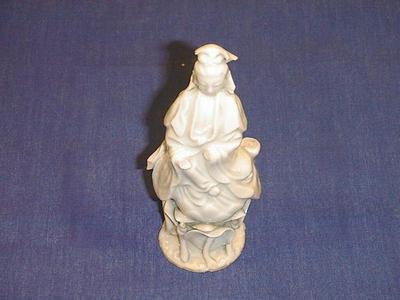E0387: Figurine
Ethnographic
Identifier:
E0387Classification Category:
8:Communication Artifacts ➞ Art/Folk ArtMaterials:
clay ➔ ceramic ➔ porcelainDimensions:
13 cm L5.5 cm W
4.3 cm H
Provenance of Object:
This object is likely of Chinese origin. This is firstly based on the fact that the object is specifically identified Guanyin in the original lab report. Gaunyin, although a consistent figure across many forms of Buddhism, goes by a number of different monikers as well. She, in a male form, is also known as Avalokitesvara in her Theravada Buddhist roots and as Kannon in Japanese Buddhist traditions. Guanyin in her Chinese identity is also specifically recognized by the simple white robe she wears, a garment meant to symbolize the purity of her being and distinguish her from her male predecessor. There is also the fact that this figurine appears to be made out of porcelain, a crafting material first mastered by the Chinese.This specific style of porcelain further indicates the origin of the statue as well. An initial search for images of porcelain works most commonly shows works that fall more into the "fine china" designation. However, further narrowing the search specifically to porcelain portrayals of Guanyin reveals a trend more closely related to the statue in Luther's possession. "Blanc de Chine" porcelain- literally meaning "white from China"- was a specific style of porcelain which began to be crafted in the late Ming Dynasty. Multiple articles with images of museum collections with "Blanc de Chine" pieces showed many different pure white porcelain Guanyin statues. Although the art form eventually expanded to to other regions, "Blanc de Chine" was long unique to the style instead of a mass-produced knock-off, this could indicate that Dehua county was this statue's home. (Hist361)
This object was held in the museum that Luther College started in 1877. This museum eventually grew into the Vesterheim Norwegian-American Museum, and following this, non-Norwegian American ethnographic objects were returned to Luther and accessioned into the college’s Anthropology Collection. Without additional documentation, was likely obtained by the Luther College Museum (later the Norwegian-American Museum) between the late 19th century and early 20th century.

